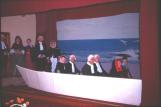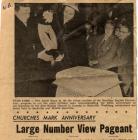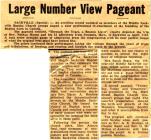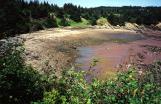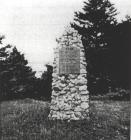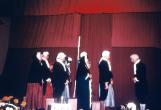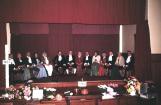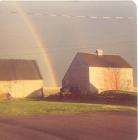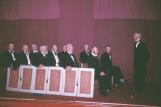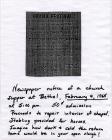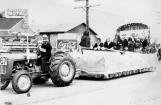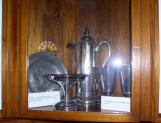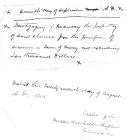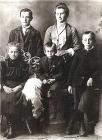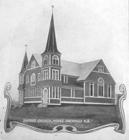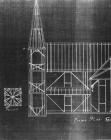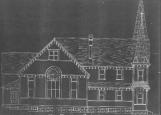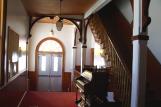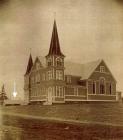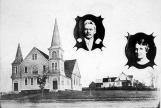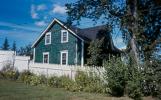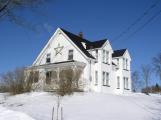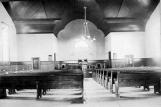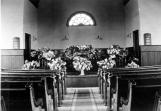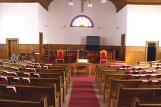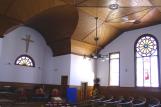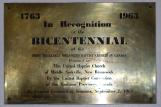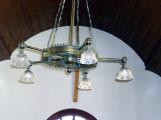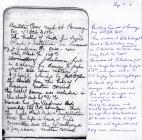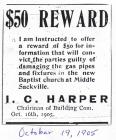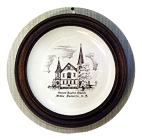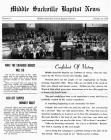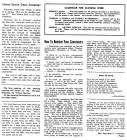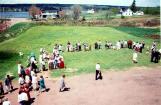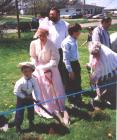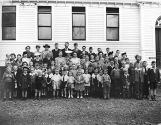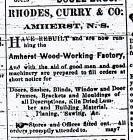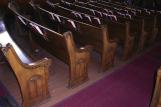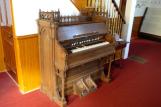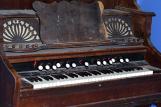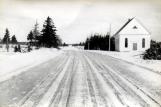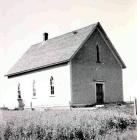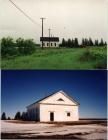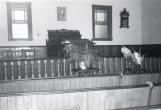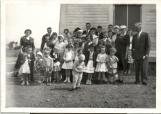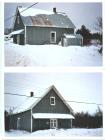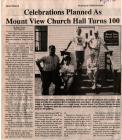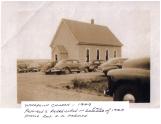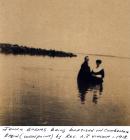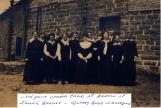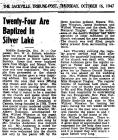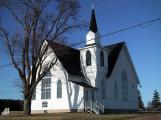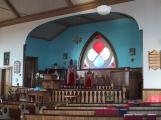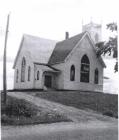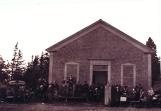

Baptist Heritage Center
Moncton, New Brunswick
2
Historical Time Line for Middle Sackville United Baptist ChurchApril 1763 13 Baptists from Swansea, Massachusetts arrive in Tantamar to establish a Baptist Church and settle near Silver Lake in Middle Sackville.
1771 A church of 60 members has been established; however most of the original group of 13 return to their homes in Massachusetts. Church continues to meet in members' homes.
1781 The "New Light Movement" evangelist Henry Alline visited Middle Sackville and stirred many hearts towards God.
1798 Church was rejuvenated. Elder Joseph Crandall was the first Baptist minister to be ordained in New Brunswick.
1809 A meeting house was built. (Some think that a log cabin preceded this.)
1839 A parsonage (a residence for the pastor) was built. The question of whether to record the deed in the pastor's name ruptures the church congregation.
1839 Bethel Chapel, also referred to as the "Second Church", was organized by the members who left the "First Church".
1842 Bethel Chapel opened
1844 The "First Church" opens Beulah meeting house at "Four Corners."
1849 To serve the increasing number of Baptists who lived closer to the developing economic center of Sackville, the Bethel Chapel congregation supported the construction of the Salem Chapel.
1850 Members sent out from the Beulah Chapel to form the Point de Bute Church.
1859 Members sent out from the Beulah Chapel to form the Midgic Church.
1861 Congregations of Bethel and Beulah Chapels called one pastor to serve both congregations. This pastor served for almost 12 years. Since 1846 at least four pastors had served both congregations at the same time although for shorter periods of time.
1871 Sustained attempts were made to reunite Beulah and Bethel Chapels.
1883-1885 The reunion process of the two congregations was successful.
1890 Main Street Baptist Church built to accommodate the exploding population of Sackville.
1902 Congregations realign geographical perimeters to officially identify two separate fields of ministry forming the Main Street and Middle Sackville Baptist Churches.
1905 Both churches join with other churches from New Brunswick, Nova Scotia and Prince Edward Island to form the denomination called "The United Baptist Convention". It is currently known as the Convention of Atlantic Baptist Churches.
1905 The current Middle Sackville United Baptist Church building is constructed.
1963 200th Anniversary celebrations include a major drama presentation "Through the Years – A Beacon Light"
1995 Congregation approves a long term major repair, renovation and expansion project (est. $670,000).
3
1963 – On the 200th anniversary of their founding, members of the Middle Sackville Baptist Church staged a pageant entitled "Through the Years, A Beacon Light" –a re-enactment of the founding of the Baptist work in Canada.5
The Landing of the Swansea 13The inspiration to establish the Middle Sackville United Baptist Church (1763) had its roots in the Second Church of Swansea (also Swansey), Massachusetts which in turn resulted from the work of Roger Williams. In 1637 Roger Williams, pastor of the Salem Puritan congregation, was expelled from the church and the colony of Massachusetts for preaching a "different doctrine". All residents of Massachusetts were expected to worship only in the state sponsored church, to educate their children in its doctrine, and to pay their tithes to the state church, regardless of their personal church membership. This was enforced by the legal authorities with stiff punishment for violators.
Roger Williams, along with some members from the Salem Church, moved to Providence where he established a church that differed from most of the old-line churches. He held to the principle that "Everyone should have liberty to worship God according to the light of their conscience." This new teaching spread throughout what is now Rhode Island, Connecticut and beyond. During this time Roger Williams identified himself with the Baptists (a group of dissenters from the Church of England). The Baptists rejected the idea that membership in the state sponsored church was required of every citizen in order to participate in government. In 1639 Roger Williams organized the first Baptist church in North America – at Providence, Rhode Island.
On April 2, 1763 a group of thirteen Baptists from the Second Swansey Church, Massachusetts and Rehoboth and Providence, Rhode Island churches decided to form a church planting team and travel to Tantramar in the British settled area of Nova Scotia (now Middle Sackville, New Brunswick). This appears to be a unique situation in early British North American history where a group was organized as a church with its own pastor outside the provinces and sent in for the express purpose of establishing a new church. The members of this group of pioneers were: Rev. Nathan Mason and his wife, Oliver Mason and his wife, Experience Baker, Benjamin Mason and his wife, Charles Seaman and his wife, Thomas Lewis and his wife and Gilbert Seaman and his wife.
9
Slacks Cove 2003 picturePossible landing site for the Swansea Baptists
11
Monument to Swansea Group Landing at Slack's CoveThe cairn located at Slack's Cove, Rockport and bearing the names of thirteen settlers traditionally marks the area where these men and women came ashore. Although located in a rather remote area, the cairn is visited by many people each year. It was erected in 1973 by men of Main Street and Wood Point Churches.
13
"Through The Years, A Beacon Light" - Pagent performed April 1963The group of 13 Baptists from Swansea (USA) establish a Baptist Church in Middle Sackvlle
15
However, in 1771 most of the group of thirteen returned to their former homes. Left behind were a number of the original settlers and new converts, 47 in all, who continued as a worshipping fellowship. They acknowledged that a man from their own church had the gifts of pastoral ministry and licensed Deacon Charles Seaman to be their Preacher.17
The first meeting house was built in 1809. After Bethel Chapel was organized in 1842, the "First Church" continued to use this building until they completed Beulah meeting house in 1842. Around 1870 the first building was sold and moved across the road to serve as a barn. Additions were constructed to the original structure which significantly changed the appearance of the building. People who were familiar with it said that inside the barn the shape of a gothic window was still visible as was the plaster on one wall. The barn stood until about the year 2000.19
"Through The Years, A Beacon Light" - Pagent performed April 1963Bethel Chapel-seating with doors to pews still in place.
Bethel Chapel was the second Baptist Church to be formed in Middle Sackville. It came about as a result of disagreements with other members of the first Church.
This picture represents a time when the pews at Bethel had doors at the aisles and members purchased the right to sit in a particular pew. In1880 the old seating at Bethel Chapel was replaced with pews without doors. This action disturbed some members so much that they would no longer come to church as they felt their seats had been taken away from them.
20
No picture exists of Beulah Chapel.When the first church building became unsuitable for further use another building was constructed and it became known as Beulah Chapel. Unfortunately, no illustration or description has been found to identify the shape (possibly 50 x 60 feet) or style of the Beluah Chapel (1844 - 1885). Also known as "Tudor Baptist Church" it was later used as a barn until it burned in 1924.
21
Probably after a Sunday morning service commemorating some aspect of Church history.1985
Middle Sackville, New Brunswick, Canada
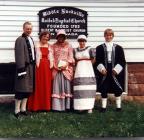
22
Early 1980's - This picture was likely taken after a Sunday Morning Service commemorating some aspect of Church history.25
This 1967 parade float celebrates the 1763 arrival of the Swansea Baptists.Most of the records of this early church have been lost. This is not unusual. According to Baptists, spiritual salvation and church membership is based upon the individual's decision to chose the way of Jesus Christ, and baptism is an ordinance that identifies the believer with the new life in Christ. A believer's salvation does not depend on membership in any organized church body. Therefore, many Baptist congregations are often nonchalant about preserving minute books and membership records, resulting in lost historical documents.
The early Middle Sackville church did not construct a meeting house, but met in members' homes. Over time through people moving, dying and losing interest in the worship services, meetings became few in number. "The New Light Movement" evangelist Henry Alline visited Middle Sackville in 1781. He wrote in his journal "The church now began to gather together in Gospel fellowship, without any bars or separation about sects or denominations, but whoever loved and sought Christ and belonged to Him were fully received into communion."
Elder Joseph Crandall who came to the Lord under the influences of the "New Light" evangelists visited Middle Sackville in 1798. Sometime between October 4 to 8, 1799 the church was reorganized with 20 members and he became its pastor. On October 8, 1799 he became the first Baptist minister to be ordained in New Brunswick.
26
Two fathers of two of our "Fathers of Confederation" pastored the Middle Sackville Church.Rev. Samuel McCully (father of Jonathan McCully- a Father of Confederation) was ordained in Sackville (1829). For a period of time he served as pastor of the Middle Sackville congregation while continuing to assist Rev. Charles Tupper (father of Sir. Charles Tupper - a Father of Confederation) with the ministerial duties at First Baptist Church in Amherst, N.S. For the next 12 years the Amherst and Sackville Churches benefited from the preaching of both McCully and Tupper.
28
Picture is of Bethel Meeting House -used as a storage barn.A deep division occurred in the church over a controversy that grew out of leadership decisions concerning the newly built parsonage. A number of members left the church and on March 9, 1839 the Second Church was organized. The meeting house they built was called Bethel Chapel (completed April 3, 1842). It was built on a site only a few yards from the old sanctuary. The pews were "sold" and brought in more than enough to pay the bills. At this time, it was common for a person or family to "purchase" the right to sit in specific seats. These church pews had doors at the aisle end of the seats to further set apart the reserved seating from others who would attend. These pew doors were removed from the aisles in 1880 to establish Bethel as a "free house" - churchgoers were free to sit wherever they desired. Some members took offence to this action and thereafter refused to attend church. Rev. Joseph Crandall became Bethel's first pastor. Nearly fifty years later the First and Second Church congregations reunited. Upon completion of the construction of the currrent church building in 1905, Bethel Chapel was sold. It was used by the Campbell Carriage Factory as a warehouse and was eventually torn down in 1951.
29
Those remaining with the old congregation were distinguished from the newly formed Bethel congregation by being referred to as the "First Church." The First Church opened its new meeting house, Beulah, in January 1844. The new site was chosen (called "Four Corners") providing a central location in the community. In 1889 this building was sold. It was used as a barn until it burned in1924.31
The Second Church built the Salem Chapel in 1848 (opened July 27, 1849) as a mission outreach to the people living in the developing commercial center for the region. The Salem Chapel was the basis for what is now Main Street Baptist located in the town of Sackville.The picture is of the Main Street Baptist Church (circa 1850).
33
Communion set from Bethel Chapel originally purchased during the 1840's."As I see the former silver dishes used at communion service in the cabinet made for them, I am reminded of my mother setting the [communion] table in the old Bethel Chapel. She had done that all my young life. On Saturday morning my father would say to her, "Remember to cook the bread for the Lord's Supper tomorrow." This was not made like everyday bread, as it was less liable to crumble when cut or broken.
Bethel [the sanctuary] was in one room, first Sunday School, a short interval, then the morning service. A slight platform was between the floor and the pulpit. The communion table was on this platform. On this my mother would first spread a fine linen tablecloth. Then place the two plates in the center. On these was the high plate on which was placed the bread. Mother had cut a square of bread about six inches deep almost to the crust. Then she sliced it down not quite to the bottom so it would not fall apart. She made small slits both ways which left cubes of bread standing together. Then [at the appropriate time in the service] the pastor broke off [the loaf] into small pieces on the plates. There on one side was the pitcher of "so called " wine. This was made each summer from blueberries and tightly bottled until needed. Then on the other side were two goblets. Over all of this my mother placed a smaller tablecloth. Then her task was done.
When I think of my mother, it is always in the church at Bethel setting the table for the Lord's Supper."
- An account of communion preparation in the 1880's & 1890's written by Ethel Thompson Berrie (1878-1971), daughter of J. Willard and Alice Thompson. She married and moved from the area in 1903.
34
Even though the Bethel and Beulah congregations were separated by animosity over the dispute, they often engaged the services of the same pastor.Pastors often traveled long distances to carry out their duties. Rev. Thomas Todd who served this pastorate (1861-1873) would usually preach at Bethel or Beulah in the morning, at Salem at 3 p.m. and either Wood Point or Coles Island in the evening. One day it was recorded that he preached at Bethel in the morning, Salem at 3 p.m., married a couple at Beech Hill and preached at Coles Island in the evening while traveling on primitive roads (a 40 kilometer trip) described as "bad and very muddy."
35
There is a notation in the record book of Second Church that Rev. Thomas Todd had been called upon to travel to Shediac (some 50 kilometers away) to conduct a baptismal service on May 14, 1865. This trip would have been taken on very primitve roads stretching through the interior of the province. It would have been a very demanding trip for a busy pastor.In the early 1860's it was reported that on one occasion during a funeral service conducted by the pastor (probably Rev. Todd), he stopped the funeral procession to the church or gravesite, while he went to the waters edge (a river, pond, or lake) to conduct a batismal service. Pastors have always had to be flexible in their approach to carrying out the tasks involved in ministry.
36
Although in 1883 the congregations of the First and Second churches voted to rejoin as one body, the minority who objected to the reunion negotiated the resignation of all officers and both pastors. The reunion was effectively established in April 1885 with the election of new officers and the calling of a new pastor.The Salem church had outgrown the Chapel and erected the Main Street building in 1890. The Chapel building was sold to the Intercolonial Railway. It burned down in 1908. The community of Sackville had been steadily growing and became the business center. Salem negotiated a separation from the rest of the pastorate. On September 22, 1902 the members agreed that Baptists living south of the Odgen Mill Road would be members of Main Street Church (formerly the Salem mission) and Baptists living north of this line should be members of the Middle Sackville Church (name changed on October 6, 1902). Of course individual members were free to go to the church of their own choice.
38
During 1905 the current Middle Sackville church building was erected.These scraps of paper seem to be hand written notes by someone giving instruction to the pastor, Rev. E. L. Steeves, regarding the wording of the church document authorizing a lawyer or banker to draft a mortgage for the proposed new church building. The new building and furnishings cost $8,193. It was built near the site of Bethel Chapel on land purchased in 1903. The house that was acquired on this property has been used as the parsonage (minister's residence) since the church was built.
39
Isaac Cook with his wife Louise and youngest daughter, Mary.1905
Middle Sackville, New Brunswick, Canada
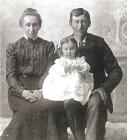
40
Isaac Cook with his wife Louise and youngest daughter, Mary. Mr. Cook was the General Contractor for building the current (1905) Building. In 1902 Isaac Cook was elected a deacon of the church.42
Five of the seven children of Isaac and Louise Cook.Back row: James and Natalia (b. 1884) Front row: Charlotte (Lottie), Garnet and Ernest.
Missing are the younger children; Mary and Leslie.
One or more of the boys may have helped in the building of the 1905 church. James was injured when he fell 20 feet off the scaffolding while helping with the construction.
43
Newspaper report of the 1905 cornerstone laying ceremony.12 June 1905
Middle Sackville, New Brunswick, Canada
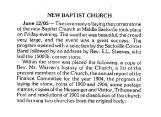
44
Newspaper report of the cornerstone laying ceremony.45
Newspaper clipping of the official dedication of the Middle Sackville United Baptist Church Building1905
Middle Sackville, New Brunswick, Canada
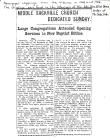
46
New Church Building DedicatedThe building was dedicated on Sunday, December 31, 1905. The Sackville newspaper, "The Tribune," reported that "A very large congregation drawn from all the surrounding country was present." Three services were held that day and once more "The Tribune" reported of the evening service "The church was again packed to the doors." The church cost $5,900 [price not including furnishings] and at the conclusion of the dedication services a debt of only $600 was outstanding. The tallest steeple reached seventy feet high.
47
Advertisement in local newspaper for train trip to Middle Sackville for church supper.1905
Sackville, New Brunswick, Canada

48
It is interesting to note an advertisemet in the local paper, the "SACKVILLE TRIBUNE":SPECIAL TRAIN TO CHURCH SUPPER
Nov. 9/05 – A special train will leave Sackville for Middle Sackville tomorrow night at 6:45 o'clock, for the convenience of those who wish to attend the supper in the new Baptist Church. Tickets for the round trip and supper, fifty cents.
The supper was a great success. The proceeds amounted to $260.
50
A postcard of the 1905 church. When it was built, the church was painted concord grey with white trim.51
A copy of the original blueprints used during construction of the 1905 building: front view.1905
Middle Sackville, New Brunswick, Canada
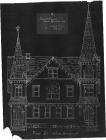
52
The original blueprints used during construction of the 1905 building.Front View of Church - 1905 Building
54
Framing Blueprint for Tower -1905 Building56
Side View - Blueprint of 1905 Building57
Front of Sanctuary. Note the rounded seats and the platform at the front.1905
Middle Sackville, New Brunswick, Canada
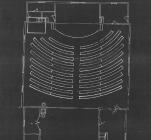
58
Front of Sanctuary - 1905 blueprintsNote the rounded seats and the platform at the front. Although provision had been made for a baptismal tank in the upper left corner it was never constructed. Baptisms were held in any body of water that permited the candidate to be completely immersed.
59
Building plans: ceiling. Note the fine detail of the ceilings.1905
Middle Sackville, New Brunswick, Canada
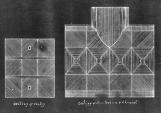
60
1905 Blueprints - ceilingNote the detailed work in the ceiling. This can still be seen today.
62
1905 blueprintsThis is the front view of the sanctuary. The choir would have been located in the front recess in the center area.
64
1905 Blueprints - back of sanctuaryThis is the view of the back of the sanctuary. The large doors would be opened to allow for extra seating in the room behind the sanctuary (the vestry). The vestry was a multi-purpose room used for Sunday School and many other church group meetings.
66
1905 Blueprints - of main entranceComparing the blueprint image above to the 2004 photo (the next image) reveals the original main entrance to the sanctuary retains much of its original style.
69
The 1905 church building (circa 1906)Note on the left (under arrow) of this early photo the horse shed built to protect horses from the extremes of the weather. It is not known for sure whether the horses were driven into the shed with the carriage/wagon/sled hitched to the horses. Possibly the horses were driven in and hitched to a spot against the back wall. After the service the horse would be backed out of the shed and readied for the return trip home.
A motion passed at the October 5, 1905 business meeting stated that the "Church authorizes trustees to erect 100 feet of horse sheds on the church property for use of the public..." "...trustees to be authorized to erect 4 sections of sheds 16 feet in the clear." - This could mean 16 feet wide.
71
Rev. & Mrs. Whitman cameos (late 1920's) photographThe parsonage is located to the right of the church building. The house continues as the residence (parsonage) for the minister.
73
This house was purchased in 1835 and served as the parsonage (minister's residence) until 1856.75
This 2003 photo is of the currrent parsonage. It was acquired in 1903 when the land was purchased for the church built in 1905.77
A view of the Sanctuary from the 1920'sThe main sanctuary was 40 x 50 feet with a seating capacity of 250 while the adjoining vestry could seat another 150 people. The sanctuary has changed very little over the years.
79
The sanctuary decorated for a 1942 wedding81
The sanctuary as it appears in 200483
The Sanctuary in a 2003 photograph.Note the fine detailed work in the ceiling.
85
A bronze plaque presented by the United Baptist Conventon of the Atlantic Provinces to the Middle Sackvlle United Baptist Church on September 1, 1963 to celebrate the church's 200th anniversary.87
Acetylene Lighting - a new innovationLighting homes and public places with acetylene gas was new in the early 1900's. The builders of the Middle Sackville United Baptist Church were willing to embrace this innovation. How long the lights were lit using acetylene gas is unknown. The pipes to deliver the acetylene gas to the light fixtures were installed at the time the church was built in 1905. The acetylene gas generator was located in the basement of the parsonage and was piped underground to the church building. It was located in the parsonage basement so the water would not freeze during the cold winter months as it would have in the unheated church building.
There is no record or recollection of any accident with the gas lights so it is assumed that the gas works were used for a number of years.
89
The "Sichy Plant" seems to refer to the acetelyne light plant. Some type of vandalism took place as Mr. Ambrose levied an extra charge of $5.00 to fix the damaged gas pipes.The Building Committee thought it a serious matter and published a $50 reward notice.91
Picture of acetylene gas generator and explanation of how it worked.1905
Middle Sackville, New Brunswick, Canada

92
Acetylene gas is given off when calcium carbide is put into water. Calcium, or calcium carbide, is a hard, porous, grayish material produced by fusing pulverized coke and air-slaked lime in an electrical furnace. The calcium remains unchanged in dry air, but if subjected to moisture it gives off a thick heavy gas which smells like garlic. This is acetylene. All that is necessary to do is to control it so that it may issue from a jet in suitable quantities, and then light it. The light given off is of a very brilliant and powerful greenish hue. This gas is highly explosive unless handled carefully.93
The central suspended chandelier was converted to electricity in 1920.2004
Middle Sackville, New Brunswick, Canada
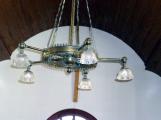
94
During the spring of 2004, Mrs. Judy Carlisle interviewed Mr. Charles Anderson, a senior member of the congregation. Both Mrs. Carlisle and Mr. Anderson are members of the Middle Sackville United Baptist Church.Mr. Anderson was born on December 25, 1919. He has been a life-long member of the community.
Topic: How the 1905 church was originally lighted.
Anderson: I can remember fixtures which were left in the entry way. The nozzles were on them. They consisted of a 3/8 [inch] pipe to carry the gas and each fixture had a valve which you could turn on with a stick. Then you could light the fixture. The acetylene was generated in the parsonage basement and piped across the field and across the yard to the church."
Carlisle: "Possibly underground even?"
Anderson: "Yes, the pipes were buried coming across the field...
95
The windows of the auditorium [sanctuary] are of rolled Cathedral glass.1905
Middle Sackville, New Brunswick, Canada

96
"The Tribune" reported, "The windows of the auditorium [sanctuary] are of rolled Cathedral glass in colors, one being a handsome memorial window to the late Willard Thompson of Upper Sackville."98
"The Good Shepherd" a memorial window to J. Willard Thompson, a deacon who died while the church was being built.100
Joseph Willard Thompson (age 29), the man in whose memory the stained glass window was dedicated, was married to Sarah Alice Forrest (age 21) on March 31, 1870 by Rev. David A. Steele of the First Baptist Church (Amherst, Nova Scotia). They were married at Amherst Point, Nova Scotia.101
Marriage Certificate for Joseph Willard Thompson and Sarah Alice Forrest.31 March 1870
West Amherst, Nova Scotia, Canada

102
The marriage certificate for Willard and Sarah Thompson dated March 31, 1870103
The Stained Glass Window on the West Side of the Sanctuary.2004
Middle Sackville, New Brunswick, Canada

104
Middle Sackville United Baptist ChurchThe other large stained glass window in the sanctuary. The symbols in the center of the windows are a reference to the book of "Revelation" chapter 21, verse 6 as found in the Holy Bible. Jesus is speaking, "...I am the Alpha and the Omega, the Beginning and the End. ..." (NIV translation)
105
Note: The first and third symbols in the window are upside down and reversed.2004
Middle Sackville, New Brunswick, Canada
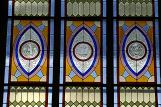
106
Note -The first and third symbols in the window are upside down and reversed. Probably the workmen installing the window were not familiar with these symbols from the Greek language. Perhaps they thought that the omega (last letter of the Greek alphabet) represented some type of container (for holding liquids?). Thus it was placed in window frame upside down. Then to place the Alpha (first letter of the Greek alphabet) in the window frame it was placed upside down. The Alpha should have been on the left side of the window since it was the beginning of the Greek alphabet107
Alpha and Omega Symbol -turned right side up and in the proper order with Bible in between.2004
Middle Sackville, New Brunswick, Canada

108
Alpha and Omega Symbol -turned rightside up and in the proper order with Bible in between.109
1905 Church and Parsonage. Carriage Factory at the right.1935
Middle Sackville, New Brunswick, Canada
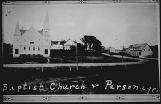
110
1905 Church & Parsonage - The Campbell Carriage Factory on the right - 1930's photograph112
60th Anniversary Bulletin Cover114
Anniversary PlateThis anniversary plate was typical of those produced in the 1960' and 1970's to celebrate a special church anniversary. Some had the anniversary dates embossed on the plate. This one does not have a date on it.
116
October 1958 Church Newsletter119
It was common in the mid 1970's to publish books of favorite recipes as fundraisers. Members of a group would submit their favorite recipes for inclusion in the book. Often the food items would have proven to be especially popular at the many suppers and fellowship times for which Baptists are well known. This book was published between 1979 -1985.121
The first recipe on this page was provided by Mrs. George Ayer. It was for Blueberry cake. The bottom recipe is for Cherry, Nut and Raisin Cake and was submitted by Mrs. Raymond Ward.123
In 1995 the congregation approved a long term major repair, renovation and expansion project (est. $670,000). At the sod turning ceremony, many from the congregation dressed in period-like costumes, surrounded the perimeter of the proposed expansion and duplicated the official turning of the sod.126
A sizable addition to the facilities began in 1995.127
Children play in the field opposite the church building.2000
Middle Sackville, New Brunswick, Canada
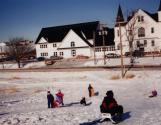
128
Children play in the field opposite the church building while many of their parents work on a voluntary basis helping to construct the new addition to the church. These volunteers worked along with the contractor and his crew.129
The significant expansion project nears completion in this 2003 photograph.2003
Middle Sackville, New Brunswick, Canada

130
The significant expansion project nears completion in this 2003 photograph.134
Sunday School of 1998There were a few who are in both photographs being children in the 1947 Sunday School photo and as adult members of the Sunday School in the 1998 photo.
136
This is possibly a pulpit chair from Bethel Chapel.Markings underneath the chair read, "Rhodes, Curry and Company, Manufacturers and Builders, Dealers in Building Material, Amherst, Nova Scotia."
R. Ernest Estabrooks wrote in "The History of the United Baptist Church at Middle Sackville 1763 -1953" that "During the early part of 1880 Bethel Chapel was renovated. The old pews with their doors were done away with and new pews were placed there by Rhodes & Curry of Amherst." Later in his account of the church's history he identifies donations of furnishings and writes that "When Bethel was renovated in 1880, Messrs. Rhodes & Curry of Amherst had contract for the new pews. This firm donated the Pulpit Chairs at that time." Therefore, it is likely that this chair was one of the ones donated by Rhodes, Curry & Company.
139
This pulpit has been in use for many years. It may well be the pulpit from the Bethel Church (1844-1885).141
Notice the Gothic Arch design in the end of each pew. These pews may have been supplied by Rhodes, Curry & Company of Amherst, Nova Scotia. They have contoured seats and backs making them exceptionally comfortable.143
Before electricty was installed this pump organ was used to provide music for the congregation to accompany the singing of hymns. This organ continued in use long after electricity was installed. The foot pedals located at the front bottom center were operated by the organist's feet which forced air from the bellows through specially designed tubes which made the musical sound. Charles Anderson, an elderly member of the congregation, said in 2004 that he recalled his parents saying this organ was donated to the church in 1905 by Cynthia Smith (nicknamed "Tin Smith"). Although not a member of the church, she played the organ at services for a period of time.145
The large slot in the right side of the organ was fitted with a handle which was used to pump air into the bellows. The small ball-like knob next to the slot would rise and fall indicating how much air was in the bellows. This guage indicated to the person operating the handle when more air was needed to be pumped into the bellows. This was considered to be a very good organ for its time.148
This organ is older than the previous one shown. It is possible that this organ was used in either Bethel or Beulah Church. The bellows which creates the air pressure needed to operate the organ was operated by the foot pedals found at the center of the bottom of the front of the organ.150
REACHING OUT TO SURROUNDING COMMUNITIESThe first half of the 1800's most people drove their horse and carriage (a wagon if a family was too poor to afford a carriage), or in winter a sled, a lengthy distance from the surrounding areas of Wood Point, Cookville, Centervillage, Mount View (Beech Hill), Harper's Brook, Coles Island, Westmorland Point, Rockport, Bay Verte, Jolicure, Midgic, and Point de Bute. Many of these members would become the nucleus of local congregations in their own areas. They would be dismissed from the "mother" church with joy to plant "daughter" churches. Some congregations would remain small and continue to meet in homes and community halls and be led by lay pastors. Others established worship centers (meeting houses or church buildings) and supported their own pastor. Some shared the cost of having an ordained clergy man as their pastor.
152
The picture is of the Cookville Church building - Currently (2004) being used as a farm machine shop.The Cookville Church was organized in 1866. It continued to be part of the Middle Sackville pastorate until it closed in the late 1960's.
154
Centervillage Church buildingCentervillage was organized in 1886. The church continued as part of the Middle Sackville pastorate until around 1990.
156
Point De Bute Church (1957) exterior views. This church built around 1856 was closed in the late 1980's. The building was moved from its original site to an adjioining piece of land where it was used as a farm building until it was demolished in 2004.Notice the farm equipment in the upper photo.
158
The Point de Bute church was organized in 1850 by 19 people who transferred their membership from the Beulah Church. The church was later renamed Upper Point de Bute.160
Pointe de Bute Sunday School -- 1960162
Harpers Brook Hall was once used for worship services. Older residents remember Baptist Church services being held in the community hall. When the means of travelling became easier, many began attending the Midgic Church. It was never designated as a church building but served the community's need for a central gathering place.Now the hall is maintained as a community center by Women's Institute.
163
Mount View Church Exterior view and interior view. Set up for a fund-raising tea.23 September 2004
Mount View, New Brunswick, Canada

164
Mount View church hall was built in 1898. Significant repairs were made on the building in 1998. Today (in 2004) it continues to be heated by the hall's two original stoves made in the Sackville foundry. The old country school stands nearby. In years gone by many school functions were held at the church hall. As the years passed by many members tended to attend the larger Middle Sackville Church. As late as the 1980's occasional services and prayer meetings were held in the hall "on the hill".Former Church interior - Here it is set up for a fund-raising tea to help with the costs of maintaining the building.
167
Wood Point Church -- 1949 photoThere are records of occasional services by the Middle Sackville pastors at Wood Point during the period of 1846-1848, and of more regular services in 1865. "A neat and comfortable house of worship" was erected in 1879. In the 1880's the ladies of the Woman's Missionary Aid Society of the Middle Sackville Baptist Church met with their "sisters"in Wood Point on occasion. In 1949 the church building was repaired and turned to face the main road.
169
Wood Point Church Baptism on the shore of Cumberland Basin.Baptists practice believer's baptism by full immersion. Baptist congregations often went to rivers, lakes and seashore to baptize believers before many of the churches installed baptismal tanks in their sanctuaries
171
Wood Point Church Choir at Baptismal Service.174
These 2004 photos show the exterior and interior of the Midgic Baptist Church.The Midgic Church was organized in 1859 when a group of members received their "letters of dismissal" from the Beulah Congregation. The "Letter of Dismission" stated that the member was in good standing in the "dismissing" church and was free to join the "receiving" church.
177
This picture of the 1897 building shows the original steeple which was replaced in the 1980s. This was the second building built by the Midgic congregation.179
Rockport Baptist ChurchThis picture is of an outdoor service held in the church yard during the late 1930's. The building was never wired for electricity so the use of a public address system depended upon battery power. Two of the men on the platform were Rev. Henri Lanctin Sr. and Licentiate Dollard.
Rockport Baptist Church was organized in 1875. By 1883, when it was reported to have 31 members, it was a separate church not dependent on the pastor of the Middle Sackville Church. However, by 1936 it became a part of the extended field served by the pastor of the Middle Sackville Church. The last known service was held in 1950 and the building was demolished in 1956.
181
Mission and outreach takes many forms such as:There are many references to the pastor conducting worship services in Coles Island. There is a map of the Coles Island area that indicates a school and a church lot. Rather than actual building lots they may have been parcels of land set aside for the purpose of gathering a hay crop that was sold and the proceeds given for the support of the local school or church.
The picture is of the CBC Radio International broadcast towers located on the land that used to be occupied by the tiny community of Coles Island which is on the Tantamar Marsh just outside Sackville, New Brunswick, Canada.
Another example of using the sale of crops harvested to support the local work of Christian ministry was found at Mount View (Beech Hill). The members planted a bushell of potatoes and gave the proceeds to missions.
182
Acknowledgements and Credits for Photos and Content:The Middle Sackville United Baptist Church Archives
Mrs. Judy Carlisle who carried out much of the research that provided content and images
The Baptist Archives at Acadia University at Wolfville Nova Scotia.
Rev. Charles O. Hudson
Article on Acetylene Lighting used by permission of the Legacy Preservation Library http://www.usgennet.org/usa/topic/preservation/

